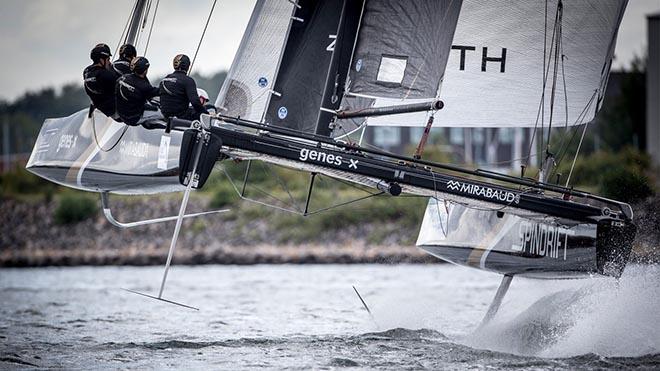Extreme flying - GC32 designer Martin Fischer talks foiling
by Extreme Sailing Series on 20 Nov 2015

Fully powered up the GC32's fly downwind Sander van der Borch / Bullitt GC32 Racing Tour
With the Extreme Sailing Series™ moving to the hydro-foiling GC32 catamaran in 2016, German naval architect and GC32 designer Martin Fischer talks through the technicalities of how these unbelievably fast rocketships rise up out of the water and fly across the surface.
Dr Fischer, who is at the forefront of the revolution in sailing brought about by the invention of foils, has got used to simplifying the complex design features and theories that underline a step-change in sailing that has already turned the leading edge of the sport into a hybrid between yachting as we thought we knew it and flying.
The key innovation is the foils, the slender carbon-fibre winglets or arms that are deployed under both hulls of the GC32 and provide the magical ingredient – lift. This is what enables the GC32s to rise up above the surface and fly in the air above the waves, travelling at speeds that would be unimaginable on conventional “displacement” boats.
“The foils work like wings on an aeroplane,” explained Dr Fischer, a physicist and specialist in fluid dynamics who has worked on America’s Cup yachts, Volvo Ocean Race yachts and maxi-multihulls for solo sailors. “The foils do two things at once on the GC32. They provide lateral resistance to counteract the sideforce created by the sails but, in addition, they also create a vertical force that pushes the boat up.”
And here’s the critical bit: “The faster you go, the more powerful this upwards force is and, at a certain speed, the vertical lift is big enough to carry the whole weight of the boat out of the water, just as a wing on a plane lifts the fuselage off the ground.”
One big difference between a racing catamaran and a plane is that a plane needs to keep rising to reach an altitude at which it can fly safely. By contrast a boat can only rise a relatively small amount before its foils lose contact with the water. If that happens the foils stall and the boat suddenly crashes into the weaves and stops. Not good.
To stop the GC32 rising too high, Dr Fisher worked out a profile for the foils so that the height of the boat stabilises automatically. “We opted for a V-shaped foil,” he said. “The specificity of this shape is such that it stabilises the foiling height automatically without any interaction from the crew. That makes it pretty easy for an inexperienced crew to sail this boat.”
In comparison to the foils that we saw being used at the 2013 America’s Cup in San Francisco, the foils on the GC32s are quite big. This is because you need bigger foils to generate lift in light airs and, unlike the big cats on San Francisco Bay where there was plenty of wind, the GC32s need to work in a broad range of conditions and often very light winds.
The critical element is the take-off speed. At what point will the boat come up and start to fly? After running a series of simulations Dr Fischer arrived at a take-off speed of around 16 knots of boat speed. This is achieved in about 14 or 15 knots of wind when the boats are going to windward and about eight knots of wind when the boats are going downwind under spinnaker.
Fischer knows perhaps better than anyone what it will take to race them at optimum performance. He says that with so many control points to adjust – rudders, sails, foils – trimming the boat and understanding where to deploy crew in terms of weight and balance will be critical. He predicts that subtle variations across the Extreme Sailing Series fleet will make all the difference in any given set of conditions.
Overall, however, the key will be managing the transition between displacement mode and foiling, especially at the turning points on the course. “Tacking and gybing are not so easy because on a foiling boat the speed is really high and during a gybe, for example, you lose a lot if you get back to displacement mode,” said Dr Fischer. “In order to reduce that loss, the crew have to be able to perform foiling gybes and that requires quite a bit of training, especially on a boat like the GC32 that does not have hydraulic systems to control the foils like on the America’s Cup boats.”
For everyone this is going to be an exciting season in the Extreme Sailing Series. For Dr Fischer, the adoption of the GC32 class is a special moment. “It is very exciting to have the GC32 in the Extreme Sailing Series. I am very proud of it.” he said.
If you want to link to this article then please use this URL: www.sail-world.com/140208